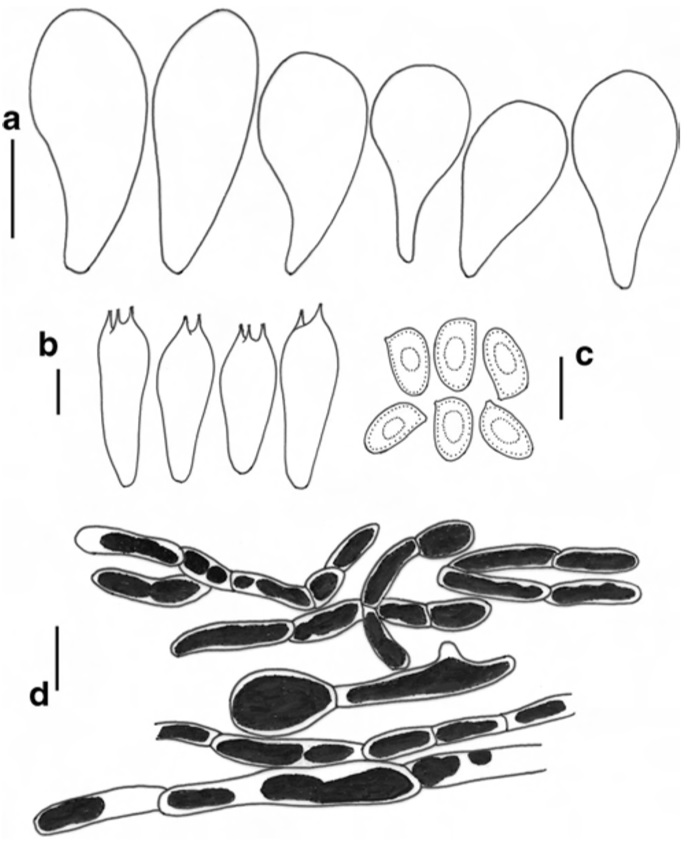Agaricus atrodiscus L.J. Chen, Callac, R.L. Zhao & K.D. Hyde
Etymology: atrodicus means black disc, and here refers to the dark disc of pileus surface.
Holotype: MFLU 12-1010. Pileus 90–130 mm diam. and 9 mm thick, parabolic with truncated top when young, then hemispherical to planoconvex and finally applanate with age; surface dry, at first entirely covered with finely grey or dark grey fibrils, often densely arranged at the disc; sometimes with pileus expansion, the fibrils disrupted into tiny squamules radially distributed on a white background; margin decurved and shortly exceeding the lamellae. Lamellae free, crowded, lamellulae with more than 5 series, 7–8 mm broad, at first white, then pink, later pinkish brown and finally dark brown. Stipe 170–194 mm long, 12–21 (base to apex) mm wide, cylindrical and tapering towards the base, surface smooth, both above and below the annulus, silky, hollow, white, staining lightly yellowish when bruised. Annulus with two layers, membranous, pendent, superous, white, upper side smooth, lower side woolly, with flakes in a cogwheel arrangement, sometimes with a yellowish tinge. Odour phenolic. Context firm, white, colour unchanged when cut. Macrochemical reactions: KOH reaction positive orange. Schäffer’s reaction negative. Basidiospores 4.7–5.9×3–3.6 μm, [x = 5.2±0.28×3.3± 0.16, Q=1.44–1.78, n=20], ellipsoid, smooth, brown, thick– walled. Basidia 14–17×5–7 μm, clavate to broadly clavate, hyaline, smooth, 4-spored. Cheilocystidia 10.5–26×6–11 μm, simple, pyriform, broadly clavate, or sphaeropedunculate, hyaline, smooth. Pleurocystidia absent. Pileipellis a cutis composed of hyphae of 5–10 μm wide, cylindrical, containing dark brown vacuolar pigments, smooth, often constricted at the septa; terminal element observed cylindrical to inflated, sometimes subglobose, up to 13–20 μm wide.
Habitat and distribution: scattered or gregarious on soil, under Bamboo. Known only from Thailand.
Material examined: THAILAND, Chiang Mai Prov., Mae Sa Waterfall, 14 September 2012, collector Jie Chen & Asanka Bandara, LD 2012185 (MFLU12-1010 holotype), (isotype, HMAS).
Notes: The positive KOH reaction and negative Schäffer’s reaction, yellowish discolouration when bruised and phenolic odour, place A. atrodiscus i n Agaricus section Xanthodermatei. It is macroscopically remarkable by its relatively robust sporocarps, with grey fibrils or tiny squamules on the pileus surface and its tapering stipe. Microscopically, the spores have an average size of 5.2×3.3 μm, and the pileipellis hyphae contain dark brown vacuolar pigments. In addition to its tropical habitat, the consecutively dark grey coloured pileus containing vacuolar pigments are also found in A. endoxanthus Berk. & Broome, A. microvolvatulus Heinem., A. rotalis K.R. Peterson, Desjardin & Hemmes and A. xanthosarcus Heinem. & Gooss.-Font (Heinemann 1956; Kerrigan et al. 2005; Zhao et al. 2012). However, A. atrodiscus can be easily distinguished in the field from A. endoxanthus and A. rotalis by its robust sporocarps and its faint yellowish discolouration on stipe surface (Heinemann 1956; Zhao et al. 2012). The pileus diameter of A. microvolvatulus and A. xanthosarcus can reach to 10 cm, but they differ in having a distinctively bulbous stipe (Heinemann 1956; Thongklang et al. 2014). According to the phylogenetic analysis, A. atrodiscus appears as an unbranched lineage arising near the common ancestor of the clade named Xan III by Thongklang et al. (2014), which is one of the three major clades constituting the section Xanthodermatei also in our tree


